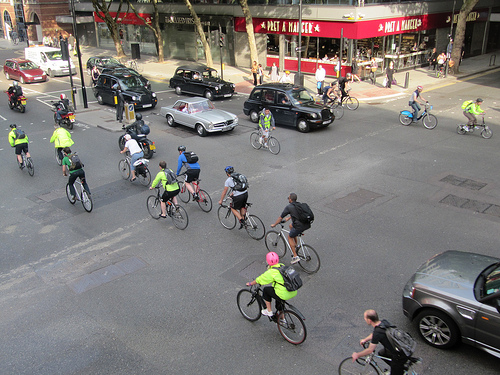 Cyclists stream along a London street.Photo: ibikelondonIn London, bicycles are gaining ground as a mode of transportation. And as in New York, the uptick in cyclists is exposing some uncomfortable divisions, stereotypes, and backlash.
Cyclists stream along a London street.Photo: ibikelondonIn London, bicycles are gaining ground as a mode of transportation. And as in New York, the uptick in cyclists is exposing some uncomfortable divisions, stereotypes, and backlash.
If there is a transportation sea change happening here — and it looks like there might be — it is not going to come without some angst. Bike riders, drivers, and pedestrians are all going to have to adjust both their attitudes and their behavior.
According to the blog Cyclists in the City (that’s “The City,” as in London’s version of Wall Street), the latest figures from London’s transportation department show a huge boom in the number of two-wheeled commuters. This runs counter to the constant hectoring of people like high-profile journalist Jeremy Clarkson, who has made sport of ridiculing people who don’t burn fossil fuels to get where they’re going, and who recently referred to cycling in The Sunday Times of London (paywall) as “a frontline propaganda weapon in the war on capitalism.”
But an article from the same edition of the Times (excerpted on the Cyclists in the City blog) paints a picture that explains why anti-cycling polemecists like Clarkson are feeling uncomfortable:
Cyclists have for the first time outnumbered motorists on some of the country’s busiest commuter routes during the rush hour.
On Cheapside, a street in the City of London, cycles make up more than 50 percent of the commuter traffic, according to official data, and account for up to 42 percent of traffic on Southwark Bridge across the Thames. In one Bristol suburb more than one in four people cycle to work. …
The surge in the number of people switching to two wheels is likely to be even greater than the new figures suggest.
Most of the data was compiled before July 2010, when 5,500 rental bikes were introduced and the first two “cycle-superhighways” — distinctive blue cycle lanes — were opened by Boris Johnson, the mayor of London.
Cyclists in the City’s author goes on to say this:
You see, Mr Clarkson. Those cyclists aren’t a front line against capitalism. If anything, as your own newspaper asserts, those cyclists are hurrying to jobs in the City of London and Canary Wharf. Far from being the warriors against banking that Mr Clarkson thinks they are, a sizeable chunk of London’s cyclists actually are bankers.
Another London bike blog, i bike london, emphasizes how pervasive anti-cycling sentiment is, despite the huge uptick in numbers and the demonstrably “respectable” nature of many of the people on bikes:
There’s a risk, outside of cycling circles, that we forget what a tabloid view some of our movers and shakers who run London actually have about cycling. To them, we don’t count because we’re a bunch of bearded yoghurt-knitting harpies who don’t deserve to be taken seriously.
In New York, as in London, the image of the cyclist is at a turning point. Advocates are rightly calling for better infrastructure to accommodate and encourage more cycling. But non-cyclists are often skeptical and fearful of what this means for them.
I have had more than one tough discussion in recent weeks with good friends who know I ride a bike and write about biking a lot. These talks usually start out with something along the lines of “I’m sorry, I know you bike, but these people on bikes are crazy/scare me with the way they act in traffic/are so arrogant/make me feel unsafe when I am walking in the city/etc.”
And as much as I wish that they were wrong, and I could just dismiss what they’re saying, I have seen everything they describe and everything they hate. I have almost been hit by a biker going the wrong way when I was on foot. I every day watch countless people on bikes endanger pedestrians, other cyclists, and themselves by biking against traffic. I see them acting, in the words of the controversial NYC DOT campaign, like jerks — riding through groups of old people in a crosswalk, for instance.
Yes, drivers and pedestrians act like jerks, too. But two wrongs don’t…well, you know. As anyone who is not part of the dominant group knows, you are held to a higher standard when you represent something other than the status quo. Fair? Nope. Reality? You bet.
The point is this: In London, New York, and countless other cities, bicyclists in great numbers are something new. New = threatening. As New York’s DOT commissioner, Janette Sadik-Khan, told me last winter, “Change is hard. Change is difficult. I like to say that people support change as long as things look exactly as they did before.”
But change is happening. And on the streets of London and New York, things don’t look exactly as they did before.



